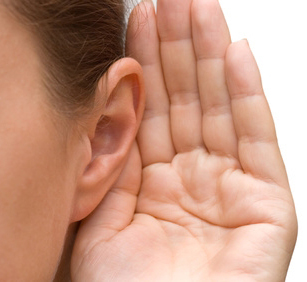 SOUNDS ODD by Elizabeth Holmes SOUNDS ODD by Elizabeth HolmesFun Facts on the Science of Sound 5. The Piercing Voice: Tell Me Where It Hertz  (VOXtra) - Ever
wonder why some voices ‘carry’ more than others? You know the ones I mean: (VOXtra) - Ever
wonder why some voices ‘carry’ more than others? You know the ones I mean:
THAT PIERCING PITCH Acoustic researchers call this phenomenon speaker’s formant. The term refers to the piercing pitch with a frequency of about 3,000 hertz (Hz), 3,000 beats per second. (Interestingly, this is the same frequency as fingernails scraping on a blackboard.) Contrast that with the lower range of human speech, which falls in the gentler 80- to 250-hertz (Hz) range. So what are ‘loudmouths’ doing differently? VIBRATIONS AND COLLISIONS A short lesson in how speech works explains the fundamentals. A flow of air from the lungs vibrates vocal folds to create "puffs” of sound. The rate at which vocal folds vibrate per second is the frequency (Hz). When vocal folds collide with each other, they create harmonics that can amplify (double, triple, etc.) the original frequency. Finally, all of this sound reaches the outside world through the vocal tract. The vocal tract is a long ‘tube’ that connects the larynx (voice box) with the outside world. AMPLIFYING THE SOUND Speakers with piercing voices also amplify these sounds in their vocal tract. By constricting and relaxing this ‘tube,’ a loudmouth changes the frequency at which sound resonates. Imagine the possibilities of being both soft-spoken and being able to project with this kind of precision. Video game actors know where I’m going with this. Just make sure you don’t mix up the two - especially if you’re recording at someone else’s studio. Anyone who’s ever been on the receiving end of a mic spike while wearing good headphones knows how painful this can be. This article was adapted from The Physics of Loudmouths: Why Some Voices Carry, by Natalie Wolchover (Life's Little Mysteries staff writer), www.lifeslittlemysteries.com, sister site to www.livescience.com. -----------------------------------------------------  ABOUT ELIZABETH ABOUT ELIZABETHElizabeth Holmes is a writer, voice actor, and staff editor at VoiceOverXtra, based in Northern California. She is also editor of VoiceOverXtra's book division, including Voice Over Legal, by voice actor / attorney Robert Sciglimpaglia. Email: Elizabeth@HolmesVoice.com |
As of the NEW website launch, 03/22/2012





.png)




There is a car dealership in Austin, TX whose owner insists on doing his own voice work for local radio and TV ads. His voice is what many would describe as countertenor or male alto. While the copy of his ads is not good, it's his voice that causes me to change stations/channels every time one of his ads begins. The higher Hz combined with a whiny timbre provokes my inner reactionary.
Now I know precisely why.
"I beg to differ with your published info on where the range of human voice/speech occurs. You claim it to be between 80-250 Hertz. NOT SO IN THE LEAST! Any musician will affirm that this particular frequency band is where a bass guitar has most of its notes, and the pedals on an electronic organ create notes in that range as well. Perhaps James Earl Jones and other noted basso profundo voices reach down with harmonic resonance in that range of tone, but human speech occurs in the area from about 250 Hz upward to 4 kHz. Vowels occur at the low end and they give the power and volume level of our speech, but consonants are at the high frequency end of things; and without consonants, there is no comprehensible articulation of human speech.
"As a voice artist and audio engineer of over 40 years, I have used spectral display devices (oscilloscopes, real-time analyzers, etc.) almost daily, to identify where certain sounds occur in our hearing band. Understandable human speech can be captured in a narrow passband of 500 - 2500 Hz. Just ask the engineers at any of the major telephone companies, as they compress and filter the audio in order to squeeze as much as they can out of the circuits that connect phones across the world. Good quality audio recording needs all the frequencies between 15 Hz and 25 kHz: BUT, the portion of the spectrum where our speech lies, is not lower than 250 and is at least as high as 3200."
Rick -- Thanks for the reminder that it's all about what the mic 'hears.' A timely tip!
Good information; now we know why there's always one person at the party that EVERYONE can hear! And why! Fingernails on a chalkboard = 3000Hz eh? OK...got it. Good stuff, Elizabeth!
I have one of those voices that easily gets buried in a room full of people. My natural pitch and normal speaking level (baritone) is very low compared to many. I've found I can easily strain my voice trying to compete with those voices that really cut through the clutter. So I just try to get closer to people and talk less.
I've found that male voices in the treble range carry much further, but can be overbearing behind the mic. Same goes for female voices. I heard some stunning female voices when at the mic, but who get lost in the crowd. The human ear can only handle so much at one time. That's another reason for each talent to choose the right mic for his or her voice. Which is, of course, a whole other topic.
Again, an interesting observation, Elizabeth!